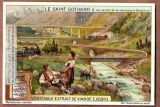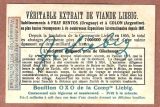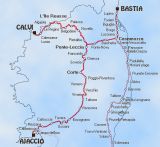RAILWAYS WITH ZIG ZAGS WORLDWIDE
EUROPE
When I started this page in 2004 I was 'reliably' informed that there were no
zigzags in Europe, nor had there ever been any.
However several have come to light - I look foward to hearing
of more, please tell me of omissions.
UK, England -
Steep Holm Military Railway, located on Steep Holm Island
in the Bristol Channel off Weston-super-Mare, Somerset. Built 1941,
closed late 1944, to install and service anti aircraft and naval
guns on the island to resist invasion as a potential base for
attack on the mainland through the Somerset levels. The island has
50 feet (15.2m) tides. Gauge 1'11.5" (600mm), rails fixed to metal
sleepers rumoured to have been stored from WW1, a cable operated
inclined railway 2/3 mile long in three separate sections,
following an existing zig zag walking path and rising to a height
of about 256 feet (78m) above sea level. Gradient 1 in 2/3. Each
section had a reversing station with points and a diesel equipped
winch house. At the top of the zig zag, a diesel locomotive
(Hunslet 0-4-0) hauled wagons to various construction sites.
Further information Kenneth Allsop Memorial Trust. (Heritage
Railway Magazine, No. 12, March/April 2000)
Northern France, Picardy
- Le p'tit
train de la Haute Somme, not far
from Amiens. It is one of the few remaining parts of the 60cm
(2'0") railways built during WWI by the British Army in preparation
for the Somme offensive. In the 1920s it was acquired by the
Sucrerie Centrale du Santerre to carry sugarbeet from the fields to
the refinery and bagged sugar from the refinery to Cappy canal
port. The line now runs: Froissy - Cappy - Dompierre. From Froissy
on the canal de la Somme it runs to Cappy. From Cappy the line
climbs to Dompierre, via a zig zag. It is a single line and the
train is propelled along the middle road.
Germany - North Rhine Westphalia - Steinhelle-Medebach Railway, with diagram.
60 km west of Kassel. Operated 1903-1953, 750mm gauge, 36km long,
it had a zig zag (double switchback) in the Dittenbach valley,
near Wissinghaanusen. The zig zag enabled the train to descend 136m in 5km.
This was unusual for central Europe.
Bo Justusson's page
Germany - Lüttmoorsiel-Nordstrandischmoor Island Railway is a German island railway
across the North Frisian Wadden Sea from Beltringharder Koog on the mainland to the Hallig of Nordstrandischmoor,
owned by the state of Schleswig-Holstein. Built 1933-34 to transport material for sea defences, 600mm gauge. There was a
switchback to cross the outer dyke at Lüttmoorsiel. See Wikipedia diagram.
Germany - Rübeland Railway in the
state of Saxony-Anhalt.
It was built between 1880 & 1886, and known as the Harz Railway (Harzbahn). It has a switchback at Michelstein.
See Wikipedia diagram.
Hungary - Nagybörzsöny Forestry Railway is described on International Steam Reverses.
Originally built in 1907 in
three sections where one end of the line was in Slovakia. It was a
600mm (2"0") horse drawn railway using 20-30 horses to draw the
wagons uphill. After WWI the border was closed and the line extended
towards an existing 760mm (2'6") line. It was relaid to the same
gauge and became a steam drawn service. In the 1930s they had 2
internal combustion engine locomotives. Regular passenger traffic
started in 1970s as timber traffic declined. At the upper end of
the line there are two reversing stations. Luckily when the line
was closed in 1976, the track was not allowed to be removed on
environmental grounds. The line has reopened as a tourist
railway.
Szob-Márianosztra Narrow
Gauge Railway is a part of the original Nagybörzsöny Forestry Railway.
Slovakia
- Kysuce–Orava Logging
Railway - two independent railways – the
Kysuce Logging Railway (KLR) and the Orava Logging Railway (OLR)
merged to form this railway. 760mm - 2'6" gauge. The connection
over the Beskyd Pass using reversing stations was "a remarkable
solution with no analogy in Europe" according to their website.
Traffic ceased in 1972, and in the same year part of the line was
proclaimed national technical heritage. Most of the track was
pulled up and the rollingstock 'liquidated'. Of the original 107.5
km 8, km is preserved. 4 Steam engines and a number of wagons were
retained. It is operated as the Historic Logging Dead-end Railway
(HLDR) under the management of the Kysuce Museum in
Čadca.
Sweden
- Glava-Bergsviken
. Operated 1886 - 1938 to take glass from the factory
in Glava to the small harbour at Bergsviken on lake Glafsfjorden,
50km west of Karlstad. 750mm gauge, 9km long.
Not a Zig Zag but sometimes described as a switchback or zigzag(s)
in the sense of horseshoe/hairpin bends:

 France - St Gotthard Line.
Mostly renowned for its spirals within mountainsides, and
some striking bridges, there also appear to be several switchbacks - tight turns, both in the
open and within mountainsides.
France - St Gotthard Line.
Mostly renowned for its spirals within mountainsides, and
some striking bridges, there also appear to be several switchbacks - tight turns, both in the
open and within mountainsides.
This imaginative trading card appears to show
two trains going towards one another! Structures do not look wide enough for two tracks.
Picture on right is reverse of that on left.
Postcards of the line, some showing maps.
France - Corsica.
History in French. Built in metre gauge 1880-94, total length is 232 Kms.
It rises from Ajaccio on the west coast through the central mountains to Ponte Lecchio, and
then to either Calvi on the north coast or Bastia on the north-east. There are a number of
tunnels, bridges, viaducts and switchbacks (lacets) in the mountain section. The Pont Vecchio
is reputedly designed/built by Eiffel. There is a horseshoe loop at Muracciole. Described as
having spectacular views.
 Description in French
Description in French
French Wikipedia
Corsican rail network
Holidays in Corsica
Germany - Thuringen - Lauscha In German.
Wikipedia article in German
Translations available for both sites, neither is good, but my German isn't good either!
From Wikipedia line diagram Lauscha station is a reversing station, if going to Lauscha.
From Google map, there a loop from the north west into Lauscha station, from which a train
can leave to go south by reversing back to the north, then going south. Not sure this is really
a reversing station rather than an end of line?
There are references on the internet to a switchback /
Spitzkehre, but nothing more detailed.
If you know more please tell me: my email address is on home page.
Germany - Schwarzwald - Lenzkirch Reference is in German, but if you pick up the title
and Google it, click on translate, it's quite a good one, with a map. Opened in 1907,
demolished in 1976. It was unusual to build a hairpin loop in standard gauge,
the station was the reason for building it, the other being that it would have been even more
expensive to bypass the town by tunnelling.
Updated 13 December 2011

 France - St Gotthard Line.
Mostly renowned for its spirals within mountainsides, and
some striking bridges, there also appear to be several switchbacks - tight turns, both in the
open and within mountainsides.
France - St Gotthard Line.
Mostly renowned for its spirals within mountainsides, and
some striking bridges, there also appear to be several switchbacks - tight turns, both in the
open and within mountainsides.
